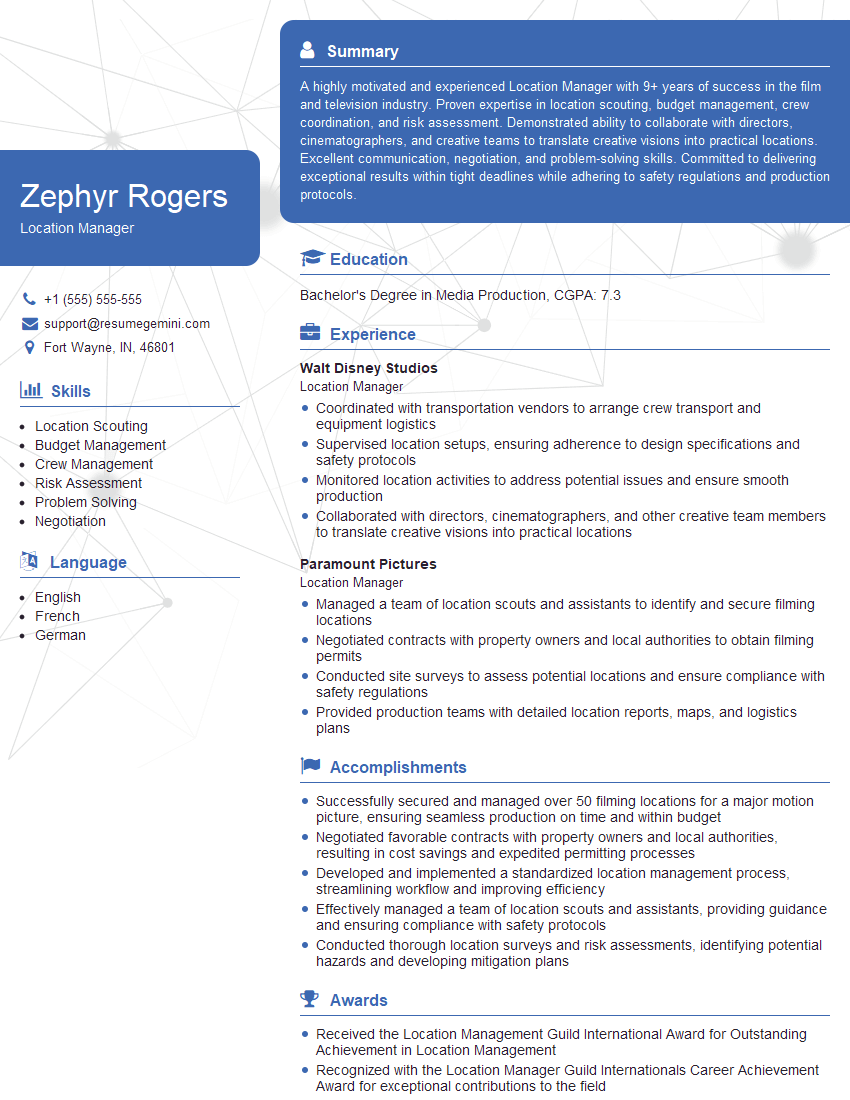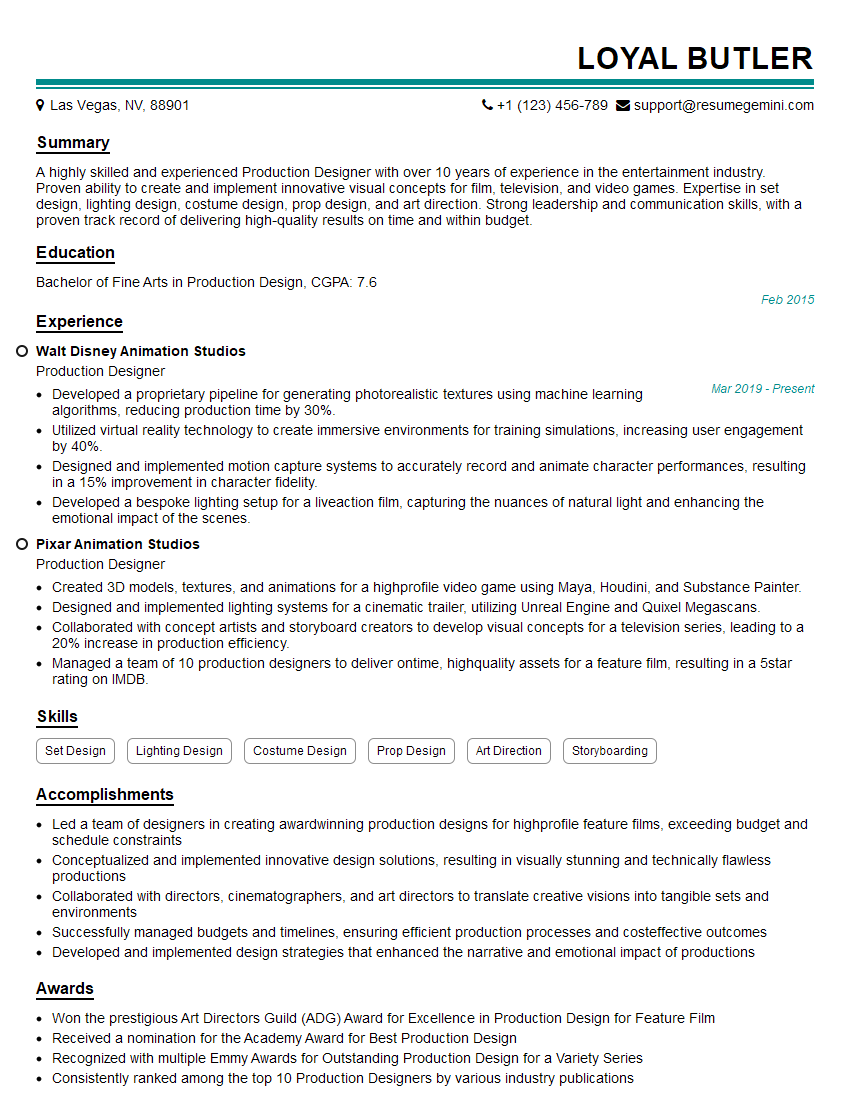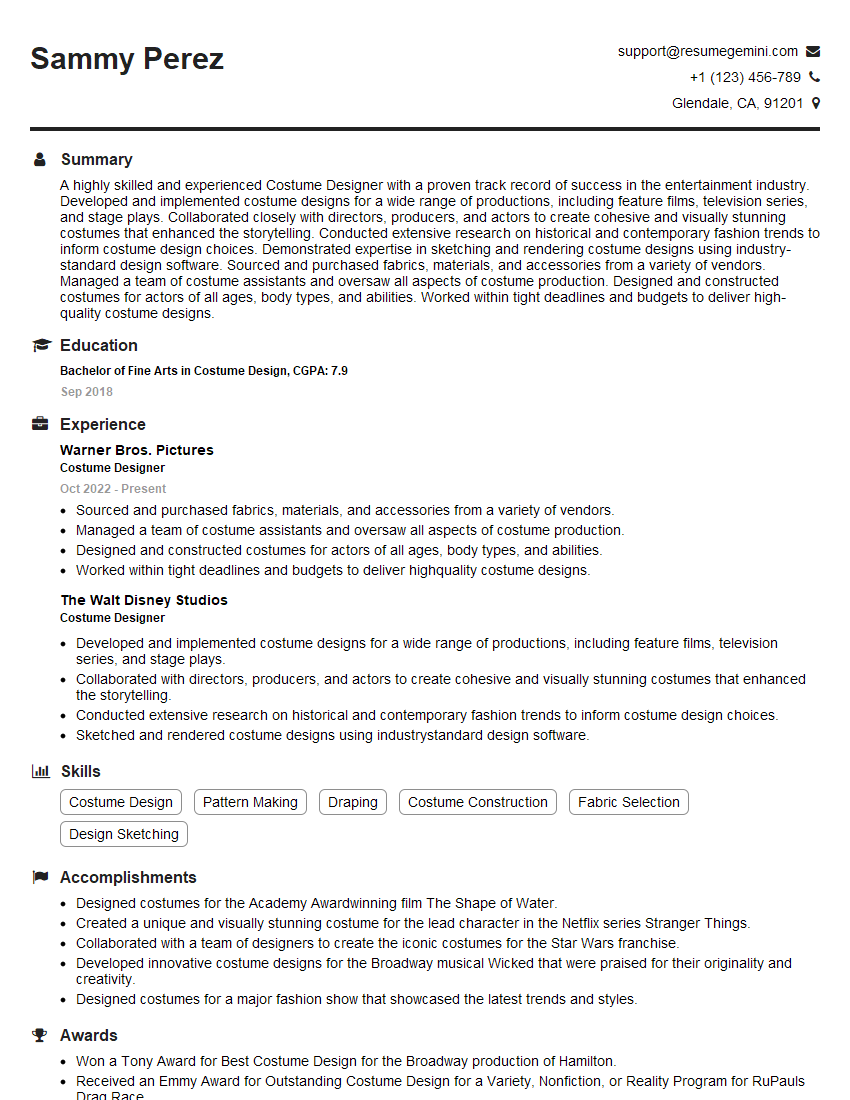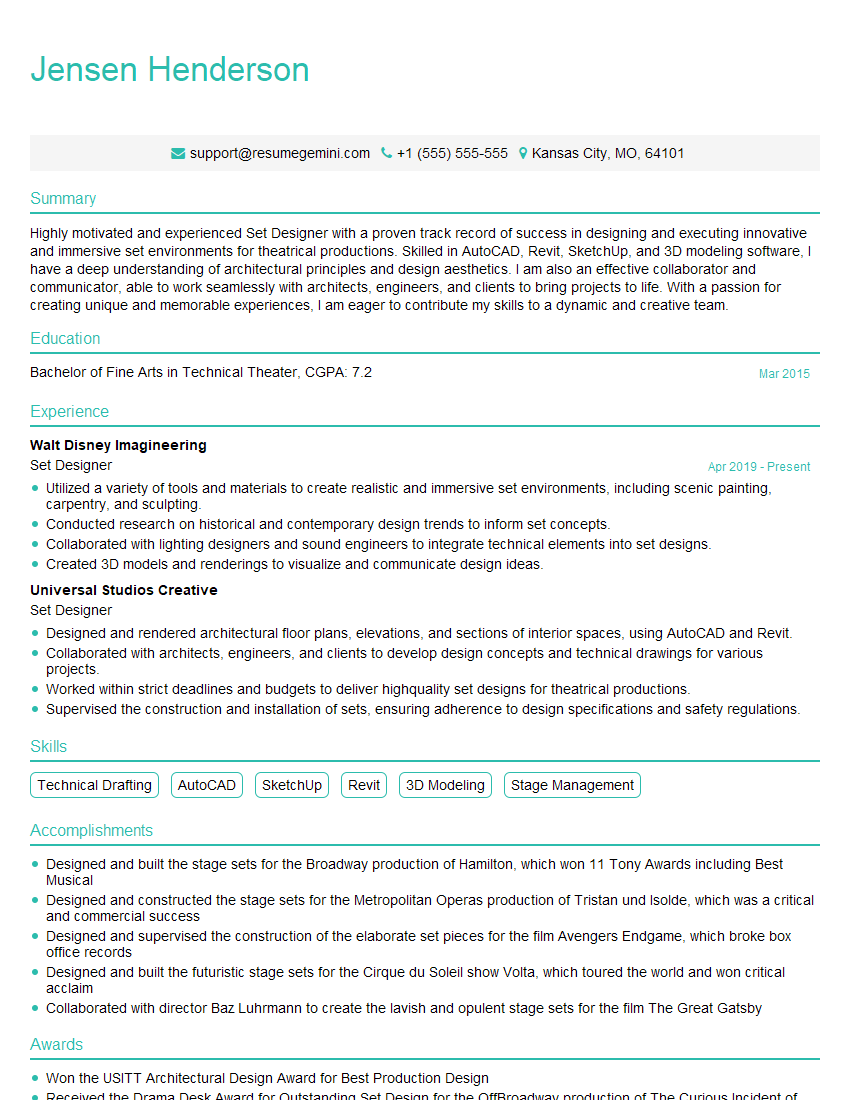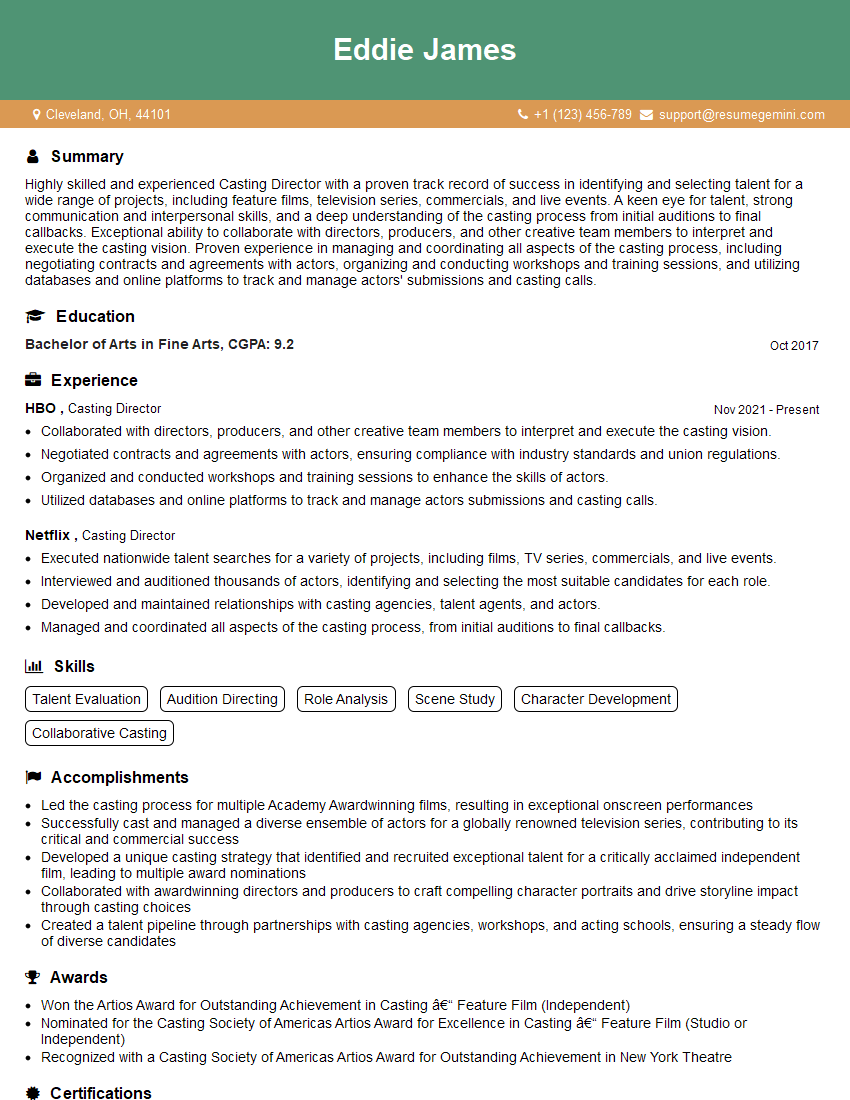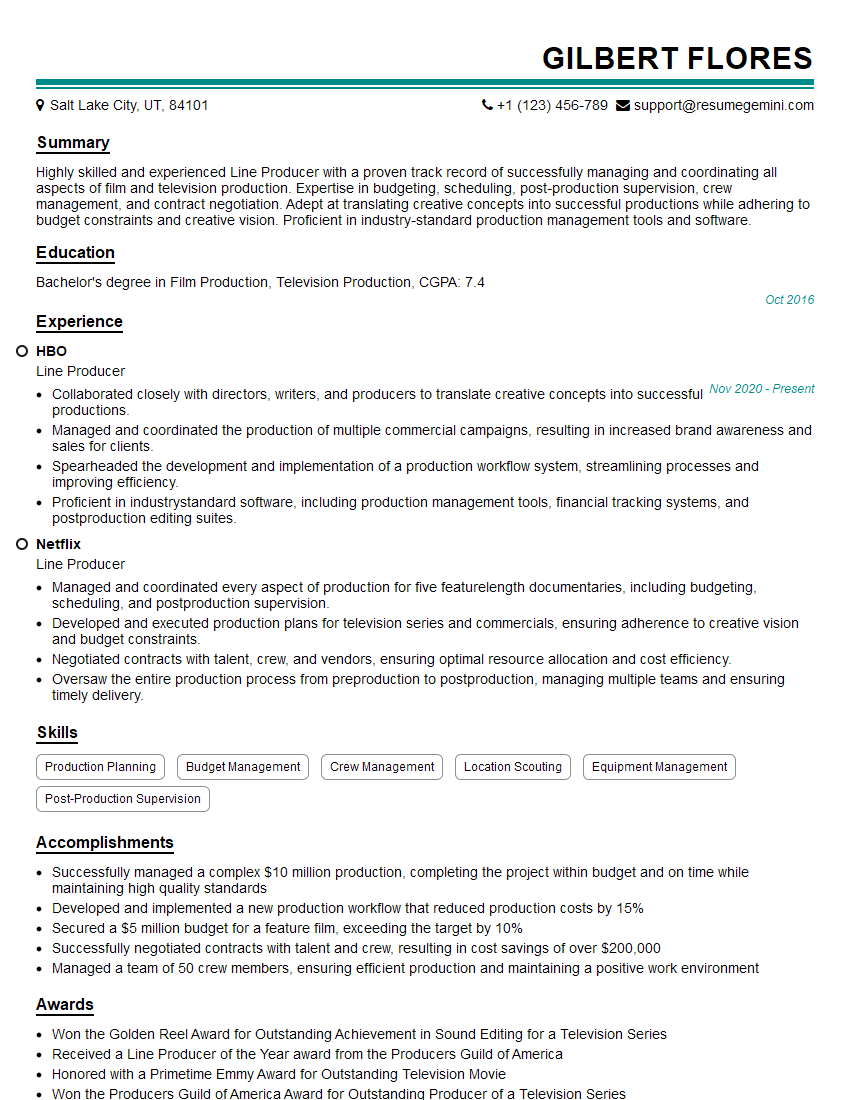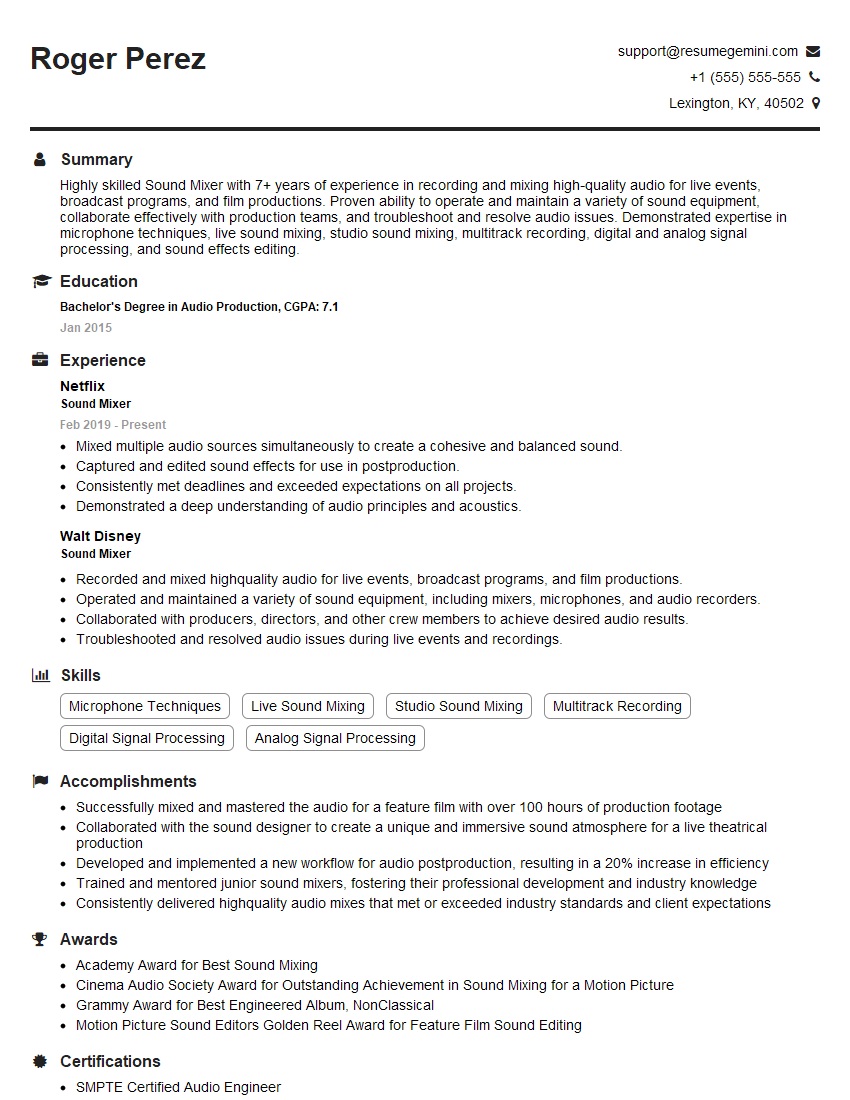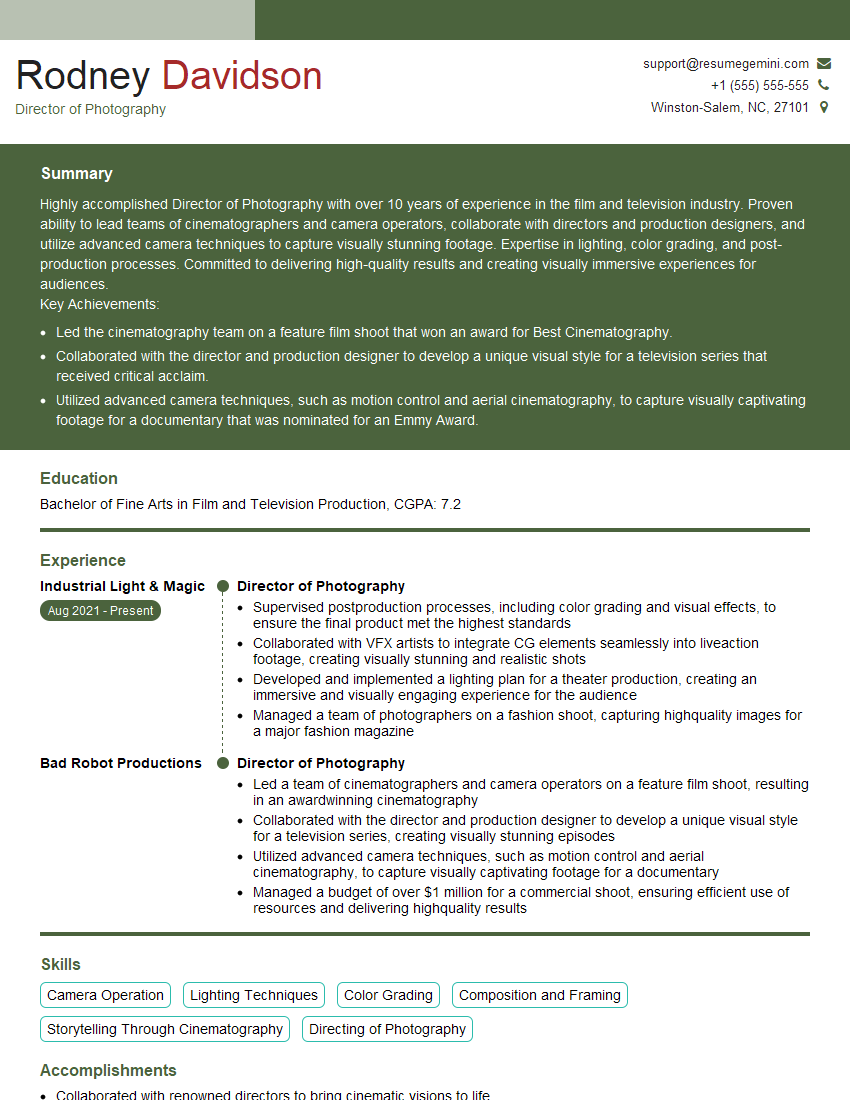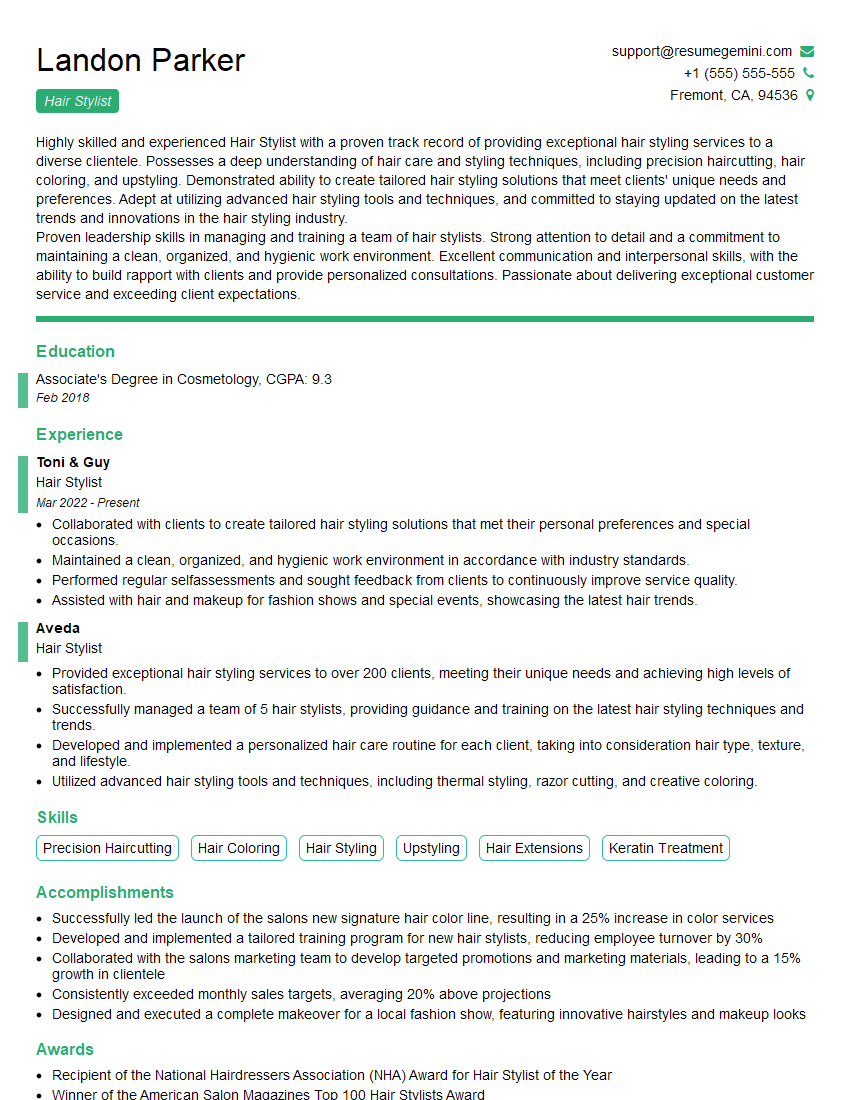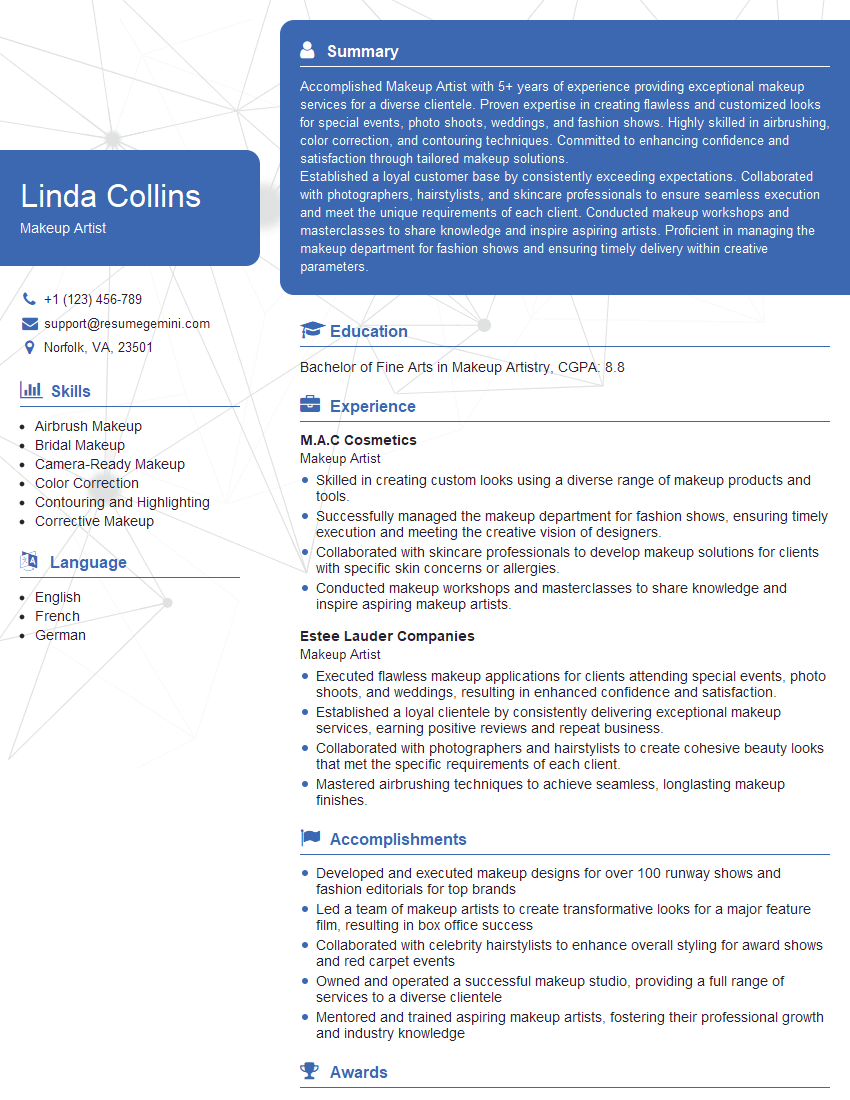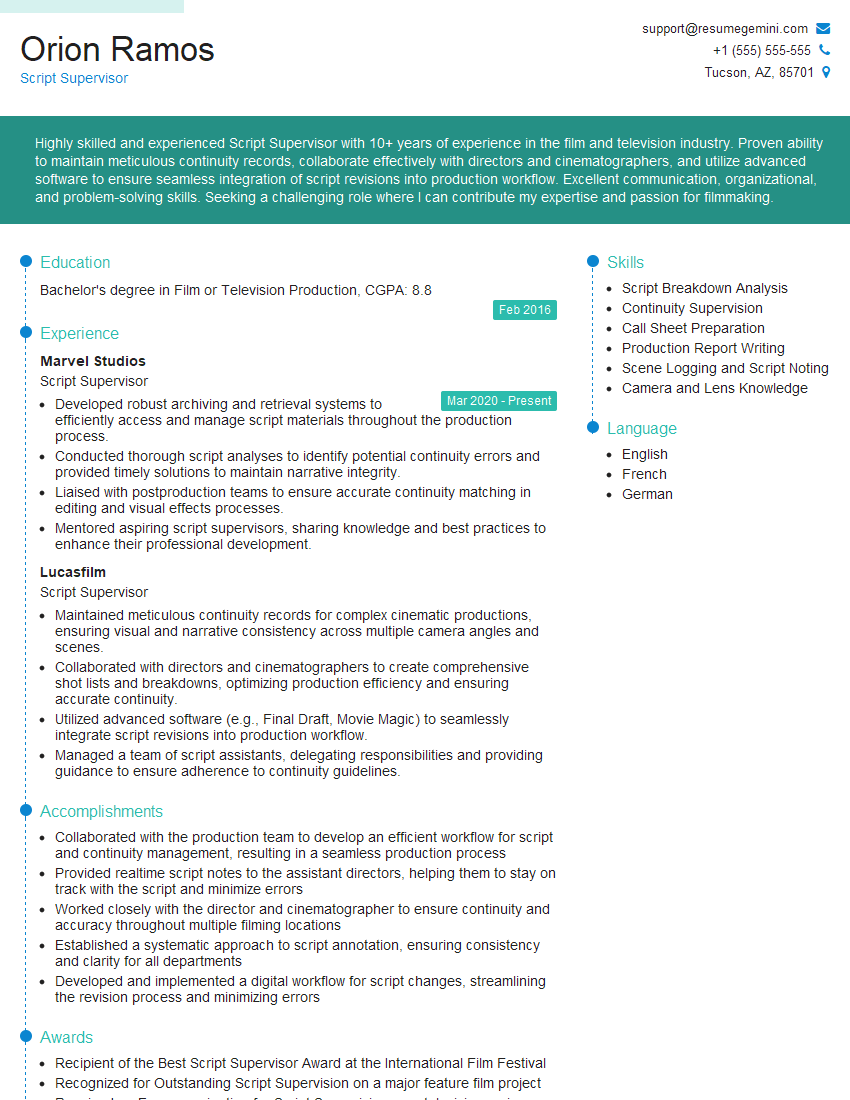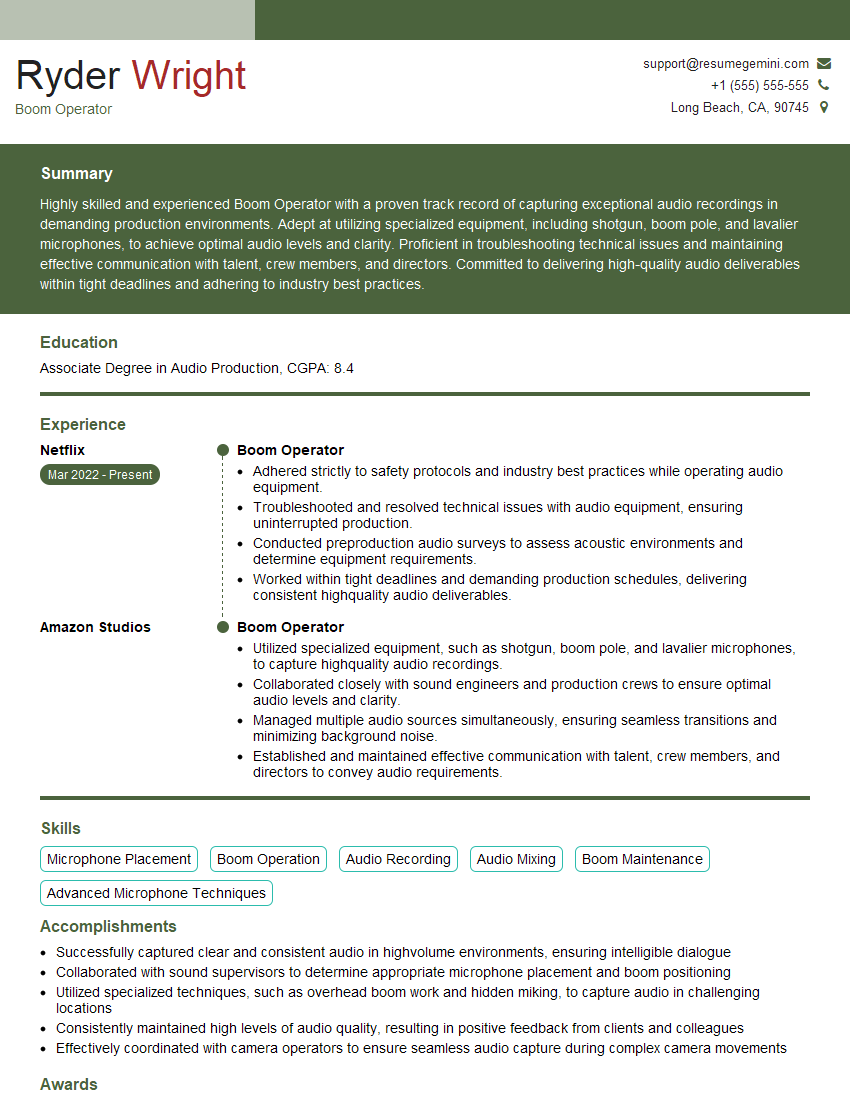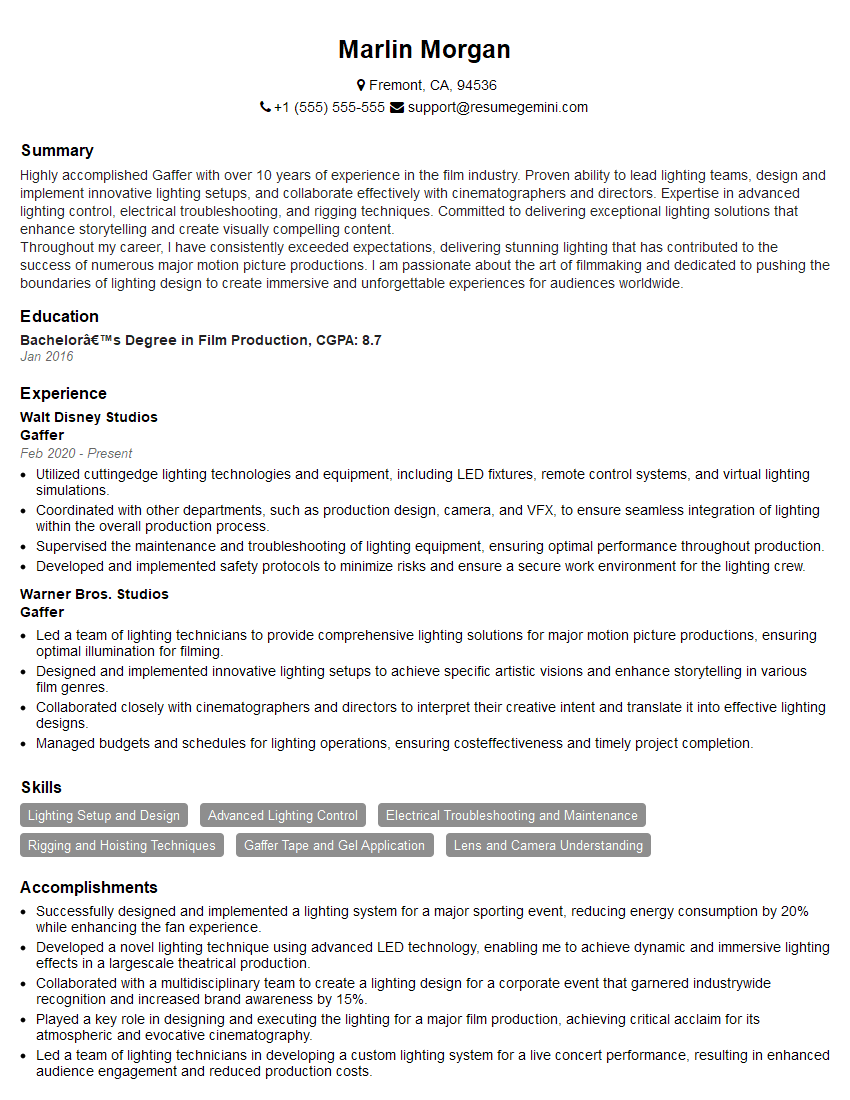Unlock your full potential by mastering the most common Film Production Knowledge interview questions. This blog offers a deep dive into the critical topics, ensuring you’re not only prepared to answer but to excel. With these insights, you’ll approach your interview with clarity and confidence.
Questions Asked in Film Production Knowledge Interview
Q 1. Explain the difference between a line producer and a production manager.
While both line producers and production managers are crucial for keeping a film production on track, their roles differ significantly. Think of the production manager as the overall organizer and the line producer as the budget and schedule enforcer.
The production manager is responsible for the day-to-day running of the set. They oversee all departments, ensuring they’re coordinated and working efficiently. They manage the crew, solve on-set problems, and maintain communication across all areas. They’re like the conductor of an orchestra, ensuring every instrument plays in harmony.
The line producer, on the other hand, is primarily focused on the financial and logistical aspects. They meticulously manage the budget, ensuring the film stays within its financial parameters. They create and maintain the shooting schedule and are responsible for negotiating deals with vendors and securing locations. They’re like the film’s accountant and scheduler rolled into one, making sure the production runs efficiently and profitably.
In short: the production manager focuses on the day-to-day operations, while the line producer focuses on the budget and logistics. They often work closely together, but their responsibilities are distinct.
Q 2. Describe your experience with budgeting and scheduling on a film set.
Budgeting and scheduling are the cornerstones of successful film production. My experience involves creating detailed budgets from pre-production through post-production, using software like StudioBinder or Celtx. This includes forecasting costs for everything from crew salaries and equipment rentals to location permits and catering. I’ve worked on both large and small-scale projects, and the process always starts with a thorough breakdown of the script, identifying the necessary resources for each scene.
Scheduling involves creating a detailed shooting schedule that optimizes efficiency. This includes blocking out shooting days, considering location availability, actor schedules, and equipment needs. I use a combination of Gantt charts and specialized scheduling software to visually represent the timeline and identify potential conflicts early on. For instance, on my last project, we had to carefully schedule scenes with the same location to minimize travel time and maximize our shooting days. Any change to the schedule is meticulously tracked and analyzed for budget impact and is approved through the line producer. Regularly reviewing the schedule against actual progress and the budget against actual costs is essential.
Throughout my experience, I’ve learned the importance of contingency planning. Unforeseen events, like weather delays or equipment malfunctions, are inevitable, so building buffer time and contingency funds into the budget and schedule is critical for preventing significant delays and cost overruns.
Q 3. What are the key elements of a shot list and how do you utilize it?
A shot list is a crucial document that details every shot planned for a film. It’s a roadmap for the director of photography (DP) and the entire crew. Key elements include:
- Scene Number and Description: Identifying the scene within the script.
- Shot Number: Unique identifier for each shot.
- Shot Type: (e.g., wide shot, medium shot, close-up).
- Camera Angle: (e.g., high angle, low angle, over-the-shoulder).
- Action: Brief description of what’s happening in the shot.
- Notes: Any additional instructions or requirements (e.g., special effects, lighting).
I utilize the shot list in several ways:
- Pre-production planning: It helps determine the equipment needed and the overall shooting schedule.
- On-set organization: It provides a clear guide for the crew, making shooting more efficient.
- Post-production editing: It serves as a reference for editors during assembly.
A well-organized shot list is essential for smooth and efficient production. I frequently update the list based on on-set decisions to reflect changes in the plan, maintaining consistency and control.
Q 4. How do you handle conflicts between different departments on a film set?
Conflicts between departments are inevitable on a film set. My approach involves proactive communication, clear roles and responsibilities, and a collaborative problem-solving mindset.
First, I emphasize open communication channels. I encourage regular meetings between department heads to discuss potential issues and collaborate on solutions. If a conflict arises, I facilitate a discussion where each department can express their concerns and perspectives. I act as a neutral mediator, focusing on finding common ground and a solution that works for everyone. This may involve suggesting compromises or finding alternative approaches.
For example, if the lighting department has a conflict with the art department over set design, I’d bring both heads of department together to discuss the challenges. We’d collaboratively explore options, possibly adjusting the set design slightly or modifying the lighting plan to accommodate everyone’s needs. The goal is always to maintain a collaborative atmosphere where all departments feel heard and respected.
If the conflict escalates, I involve the production manager or even the director to ensure the issue is resolved promptly and effectively, preventing any significant disruption to the shooting schedule.
Q 5. Describe your experience with different camera formats and their limitations.
I have extensive experience with various camera formats, including Super 35, full-frame, and large format. Each format presents unique advantages and limitations.
Super 35 offers a good balance of image quality, cost-effectiveness, and sensor size. It’s a widely used format for its versatility. However, it might not capture the same level of shallow depth of field as larger formats.
Full-frame cameras provide a wider field of view and impressive shallow depth of field, ideal for dramatic shots. The larger sensor means better low-light performance, but they can be more expensive and heavier than Super 35 cameras.
Large format cameras, such as 65mm, provide exceptional image quality and resolution, but come with significant cost and logistical challenges. They require specialized lenses and equipment, resulting in higher production costs and more complex workflow.
My approach involves choosing the format based on the project’s requirements, budget, and desired aesthetic. Understanding the limitations of each format is essential to make informed decisions and effectively plan the shoot, ensuring that the limitations don’t compromise the final product’s creative vision. The choice is always a balance between creative aspirations and practical constraints.
Q 6. What is your approach to managing risk on a film production?
Risk management is a critical aspect of film production. My approach is multifaceted and proactive, encompassing pre-production planning, ongoing monitoring, and contingency planning.
In pre-production, I meticulously assess potential risks, including weather conditions, equipment malfunctions, actor availability, and budget constraints. I develop mitigation strategies for each identified risk, such as securing insurance, having backup equipment, and building buffer time into the schedule.
During production, I continuously monitor the progress of the shoot, looking for emerging risks. This includes daily safety checks, ensuring adherence to the schedule and budget, and addressing any unforeseen challenges. Regular communication with the crew and department heads is key to early detection and proactive mitigation of issues.
Contingency planning is essential. This involves having backup plans for various scenarios, such as having alternate locations or securing additional resources if needed. A detailed risk assessment document is maintained, updated regularly and reviewed with the production team. This ensures that everyone understands the potential risks and the plan in place to handle those risks.
By combining proactive planning, continuous monitoring, and a robust contingency strategy, my aim is to minimize the impact of unforeseen events and keep the production on track, both creatively and financially.
Q 7. Explain the difference between a director’s cut and a theatrical cut.
The difference between a director’s cut and a theatrical cut lies in the length and content of the film. The director’s cut is the version of the film assembled and edited according to the director’s vision, typically longer and often more detailed than the final theatrical release.
The theatrical cut, on the other hand, is the version that is released for public viewing in cinemas. This version is often shorter than the director’s cut, having undergone edits and adjustments to meet specific time constraints, audience expectations, or studio requirements. These edits may involve removing scenes, shortening sequences, or altering pacing. Sometimes scenes are adjusted to improve the narrative flow or to align with specific marketing strategies.
Think of it like this: the director’s cut is the artist’s original masterpiece, whereas the theatrical cut is a refined, more commercially accessible version, tailored for a wider audience. Not all films have a director’s cut released officially; this depends on the studio and the director’s agreements.
Q 8. How do you ensure the safety of cast and crew on set?
Ensuring cast and crew safety on set is paramount and a non-negotiable aspect of my work. It’s not just about following rules; it’s about fostering a proactive safety culture. This begins long before the first day of shooting.
- Pre-Production Planning: Thorough risk assessments are crucial. We identify potential hazards – from working with pyrotechnics to operating heavy equipment – and develop comprehensive safety protocols. This includes detailed shot lists that account for potential risks and contingency plans.
- On-Set Safety Officer: A dedicated safety officer is always present, overseeing all activities and ensuring adherence to safety guidelines. Their role involves regular inspections, enforcing safety regulations, and immediate response to any incidents.
- Training and Communication: Cast and crew receive comprehensive safety briefings tailored to the specific production. This covers everything from emergency procedures to the proper use of equipment. Open communication is vital; everyone is encouraged to report any safety concerns, no matter how small.
- Emergency Preparedness: We have well-defined emergency procedures, including readily accessible first-aid kits, designated emergency exits, and contact information for emergency services. Regular drills ensure everyone knows what to do in case of an accident or emergency.
- Environmental Considerations: On location shoots require special attention to environmental safety. We strive to minimize our environmental impact and adhere to all relevant regulations concerning waste disposal, wildlife protection, and the responsible use of resources.
For example, on a recent period drama, we had a scene involving horses. Pre-production included extensive discussions with animal handlers, ensuring the horses were well-cared for and the scene was choreographed to minimize risks to both animals and crew. The safety officer was stationed close by throughout filming, ready to intervene if needed. This proactive approach ensures a safe and productive environment for everyone involved.
Q 9. Discuss your experience with various post-production workflows.
My post-production workflow experience is extensive, encompassing various pipelines and technologies. I’m proficient in both linear and non-linear workflows, adapting my approach based on the project’s specific requirements and budget.
- Linear Workflow: While less common now, I have experience with linear workflows, particularly in film-based projects. This involves traditional film processing, negative cutting, and optical effects.
- Non-Linear Workflow: This is my primary approach today, leveraging digital intermediate (DI) technology. I’m comfortable working with various software and formats, from capturing and logging footage to color grading, visual effects, and sound mixing.
- Software Proficiency: My experience includes working with industry-standard software such as Avid Media Composer, Adobe Premiere Pro, DaVinci Resolve, and After Effects. I’m adept at managing large media files, implementing efficient storage solutions, and collaborating effectively with post-production teams.
- Cloud-Based Collaboration: I’m experienced with cloud-based collaboration platforms that facilitate teamwork and remote access to project files. This allows seamless collaboration with editors, colorists, and sound designers, even when geographically dispersed.
For instance, in a recent documentary project, we utilized DaVinci Resolve for color grading, leveraging its powerful tools to achieve a consistent and aesthetically pleasing look across various scenes shot in diverse locations. The entire post-production process was managed through a cloud-based platform, ensuring real-time collaboration and efficient workflow.
Q 10. How familiar are you with different shooting styles (e.g., handheld, Steadicam)?
I’m highly familiar with a wide range of shooting styles, understanding their impact on the final visual narrative. The choice of shooting style is crucial to achieving the desired aesthetic and emotional impact.
- Handheld: Provides a sense of immediacy, realism, and often a more visceral, documentary-style feel. It’s excellent for capturing fast-paced action sequences or creating a sense of urgency and chaos. I understand the importance of proper stabilization techniques and camera support to minimize unwanted shakiness.
- Steadicam: Offers smooth, flowing shots that follow subjects seamlessly. It provides a sense of elegance and stability, making it ideal for tracking shots and creating a visually dynamic yet controlled aesthetic. Requires a skilled operator and careful planning of the shot.
- Dolly Shots: Smooth, controlled movements along a track, allowing for precise framing and composition. Often used to reveal information gradually or create a sense of grandeur.
- Crane Shots: Provide a broader perspective, offering sweeping panoramic views or allowing for dynamic transitions between different parts of a scene.
- Drone Shots: Offer unique perspectives and dramatic aerial shots, particularly beneficial for establishing shots or creating visually stunning sequences. Requires careful consideration of safety and regulations.
In a recent music video, we used a combination of handheld shots to capture the energy of the live performance and Steadicam shots to create smooth transitions and follow the lead singer’s movement. The careful choice of shooting styles greatly contributed to the video’s overall visual appeal and narrative flow.
Q 11. Explain your experience in pre-production planning.
Pre-production planning is the bedrock of a successful film production. It’s where the vision is meticulously crafted, budgets are carefully managed, and the groundwork for a smooth shoot is laid. My approach is comprehensive and detail-oriented.
- Script Breakdown: A thorough analysis of the script, identifying all locations, props, costumes, special effects, and personnel required.
- Budgeting and Scheduling: Creating a realistic budget that allocates resources effectively and developing a detailed shooting schedule that optimizes efficiency.
- Location Scouting: Identifying suitable locations that match the script’s requirements, considering factors like accessibility, permits, and potential challenges.
- Casting: Collaborating with casting directors to find actors who embody the characters and bring the script to life.
- Crew Assembly: Recruiting a skilled and experienced crew, ensuring the team has the expertise to handle all aspects of production.
- Storyboarding and Shot Listing: Creating visual representations of each scene, detailing camera angles, movements, and composition.
- Pre-Production Meetings: Regular meetings with key personnel to review the plan, address concerns, and ensure everyone is aligned.
For a recent short film, meticulous pre-production planning allowed us to complete the shoot within budget and schedule. Our thorough location scouting resulted in finding a perfect location that enhanced the story’s atmosphere without compromising the budget. Detailed storyboarding helped to ensure that the final product aligned precisely with the director’s vision.
Q 12. Describe your experience with different lighting techniques and equipment.
My experience with lighting techniques and equipment is extensive, encompassing both natural and artificial lighting solutions. I understand the art of shaping light to evoke specific moods, enhance storytelling, and create visually compelling images.
- Natural Lighting: Utilizing available sunlight effectively, understanding how the time of day and weather conditions impact lighting quality. This includes exploiting golden hour lighting for a warm, evocative look or using overcast skies for soft, diffused light.
- Artificial Lighting: Proficient in using various lighting instruments such as Fresnels, HMI lights, LEDs, and Kino Flo tubes. I understand the technical aspects of lighting, including color temperature, light intensity, and diffusion techniques.
- Three-Point Lighting: Mastering the classic three-point lighting setup (key light, fill light, back light) to achieve balanced and professional-looking illumination.
- Lighting for Different Genres: Adapting lighting styles to suit various genres, from the high-contrast lighting of film noir to the soft, naturalistic lighting of a romantic drama.
- Lighting Equipment: Familiar with various lighting accessories, such as barn doors, gels, diffusers, and reflectors, to shape and modify light effectively.
In a recent commercial shoot, we used a combination of natural and artificial lighting. We leveraged the golden hour sunlight for the exterior shots, supplementing it with HMI lights to ensure even exposure. For interior shots, we employed a three-point lighting setup with LEDs, using gels to create a warm and inviting ambiance that aligned with the brand’s image.
Q 13. How do you maintain consistency in visual style throughout a film?
Maintaining visual consistency throughout a film is vital to creating a cohesive and immersive viewing experience. It’s a multifaceted process that requires attention to detail at every stage of production.
- Pre-Production Planning: Defining a clear visual style guide that outlines the color palette, lighting schemes, camera angles, and overall aesthetic. This serves as a reference point throughout production.
- Shot Consistency: Maintaining consistency in camera angles, framing, and movement, especially during multi-day shoots or scenes spanning multiple locations.
- Color Grading: Utilizing color grading techniques to ensure a consistent look across different scenes, balancing color temperature, saturation, and contrast.
- Post-Production Review: Regularly reviewing dailies and rushes during post-production to detect any inconsistencies and address them promptly.
- Communication and Collaboration: Open communication between the director of photography, editor, and colorist is crucial to maintain a unified visual language.
In a recent feature film, we used a detailed visual style guide that included examples of desired color palettes, lighting schemes, and camera movements. This ensured consistency across all scenes, regardless of location or time of day. Regular reviews of the dailies allowed us to identify and resolve minor inconsistencies before they escalated into major problems. The result was a visually cohesive and immersive film experience.
Q 14. What software are you proficient in for film editing and post-production?
My software proficiency spans a wide range of industry-standard tools for film editing and post-production. I’m highly adept at using them for various tasks, from basic editing to complex visual effects.
- Avid Media Composer: Extensive experience in using Avid for editing, assembling sequences, and managing large media files. I’m comfortable using its advanced editing tools and workflows.
- Adobe Premiere Pro: Proficient in using Premiere Pro for editing, color correction, and basic visual effects. I’m familiar with its intuitive interface and collaborative features.
- DaVinci Resolve: Adept at using DaVinci Resolve for color grading, creating stunning visual effects, and mastering audio. Its versatile features are particularly suited to high-end projects.
- After Effects: Experienced in using After Effects for motion graphics, compositing, and visual effects, applying techniques to enhance the film’s visual narrative.
- Photoshop: Proficient in using Photoshop for image retouching, preparing assets for visual effects, and creating graphic elements.
For example, in a recent project, I used Avid Media Composer for the initial edit, DaVinci Resolve for color grading and advanced visual effects, and After Effects for specific motion graphics elements. The seamless integration between these software packages allowed for a streamlined and efficient post-production workflow.
Q 15. How do you handle unexpected issues or problems that arise during filming?
Unexpected issues are inevitable in film production. My approach is proactive and involves a multi-layered strategy. First, meticulous pre-production planning is key. This includes thorough location scouting, comprehensive risk assessments, and detailed shot lists. Think of it like building a sturdy house – a strong foundation prevents many problems later.
During filming, I foster a culture of open communication. The crew is encouraged to report even minor glitches immediately. We utilize a daily problem-solving meeting where challenges are discussed and solutions brainstormed collaboratively. For instance, if a crucial piece of equipment malfunctions, we have backup systems in place and a contingency plan to re-shoot scenes later if absolutely necessary, minimizing downtime.
Finally, I believe in adapting quickly. Sometimes, a seemingly insurmountable problem can lead to creative solutions. On one shoot, a sudden downpour forced us to relocate a scene, but this unplanned change resulted in a more atmospheric and visually compelling sequence than initially envisioned. Flexibility and resourcefulness are paramount.
Career Expert Tips:
- Ace those interviews! Prepare effectively by reviewing the Top 50 Most Common Interview Questions on ResumeGemini.
- Navigate your job search with confidence! Explore a wide range of Career Tips on ResumeGemini. Learn about common challenges and recommendations to overcome them.
- Craft the perfect resume! Master the Art of Resume Writing with ResumeGemini’s guide. Showcase your unique qualifications and achievements effectively.
- Don’t miss out on holiday savings! Build your dream resume with ResumeGemini’s ATS optimized templates.
Q 16. Describe your experience with working with actors and directing performances.
Working with actors is a collaborative process that centers around building trust and understanding. I begin by thoroughly discussing the character’s background, motivations, and relationships with other characters. I find that providing actors with a detailed script breakdown and character notes empowers them to make informed choices.
Rehearsals are crucial. They allow us to experiment with different interpretations of the scene and develop a comfortable working dynamic. I encourage actors to improvise within the confines of the narrative to bring authenticity and nuance to their performances. I believe in creating a safe and supportive environment where they feel comfortable taking risks and exploring different options.
My direction is primarily collaborative. Instead of dictating, I guide actors towards a desired performance by providing constructive feedback and offering suggestions. I might say, ‘Try conveying vulnerability with a slight tremor in your voice’ instead of simply telling them ‘Be more vulnerable.’ Positive reinforcement is vital for boosting morale and producing exceptional performances. For example, I always praise both the small and big successes of each actor throughout the production.
Q 17. Explain your process for selecting locations for filming.
Location selection is a crucial step. It begins with a thorough read-through of the script to identify the specific needs of each scene – is it a bustling city street, a secluded forest, or a grand Victorian mansion? The look, feel, and functionality of a location are all considered.
Next, I conduct extensive research, often using online resources and location databases. I then visit potential locations in person to assess their suitability, considering factors such as accessibility, permits, safety, and potential logistical challenges. I always aim for a location that genuinely enhances the storytelling and visual appeal of the film.
For instance, when filming a scene requiring a vintage car, we might search for locations that complement the aesthetic of the car, such as a classic diner or a quiet, tree-lined suburban street. The goal is synergy, where the location becomes an integral part of the scene, not just a backdrop.
Finally, securing necessary permits and ensuring the safety of the crew and actors on location is a vital part of the process. This can include understanding local regulations, liability insurance, and having appropriate safety measures in place.
Q 18. How do you manage the logistics of transporting equipment and personnel?
Managing logistics is a complex undertaking, requiring meticulous planning and efficient execution. It starts with creating detailed production schedules that account for every aspect, from equipment setup to crew transportation. We often employ specialized transportation companies for large-scale equipment, ensuring safe and timely delivery to each location.
We use scheduling software and digital communication tools to ensure everyone knows their roles and responsibilities and where they need to be at all times. The crew members are briefed well in advance, and transportation arrangements (e.g., shuttle buses for large crews, specialized vehicles for equipment) are meticulously organized to avoid bottlenecks and delays.
Careful consideration is also given to the accommodation and catering needs of the crew. Providing a comfortable and well-supplied environment is essential for maintaining morale and productivity. A well-oiled logistics machine ensures that the production runs smoothly and prevents costly delays.
Q 19. What are some of the legal and ethical considerations in film production?
Legal and ethical considerations are paramount. We must adhere to copyright laws, obtaining necessary permissions for music, images, and any copyrighted material used in the film. This includes securing licenses for music and sound effects, ensuring proper attribution, and avoiding plagiarism.
Ethical concerns include respecting the privacy of individuals, obtaining informed consent for filming on private property or featuring people in the film, and avoiding any portrayal that could be considered defamatory or harmful. We ensure we have the appropriate legal documentation and adhere to industry best practices to avoid any legal issues. Additionally, we often consult with legal professionals to navigate complex situations and stay up-to-date on relevant regulations.
Moreover, responsible and ethical production involves treating everyone on set with respect, ensuring fair wages and working conditions, and prioritizing safety. Building a strong and ethical production culture benefits the entire team and safeguards against potential legal problems and reputational damage.
Q 20. Discuss your experience working with different types of film stock or digital formats.
My experience spans both traditional film stock and digital formats. I’ve worked with various film stocks, from high-contrast black and white to vibrant color emulsions, each possessing unique characteristics that impact the overall look and feel of the film. The choice of film stock often depends on the director’s vision, the budget, and the desired aesthetic. Film stock provides a unique grain structure and texture that some directors find essential for a particular style.
Digital formats, on the other hand, offer greater flexibility and cost-effectiveness. I’ve used different digital cameras and sensors, understanding their strengths and limitations, including resolution, dynamic range, and low-light performance. Digital workflow offers immediate feedback, facilitating quick adjustments on set. This reduces time and resources spent during post-production compared to film. For instance, on a recent project, digital’s flexibility allowed us to seamlessly switch between cameras and aspect ratios during a complex action sequence.
Ultimately, the choice between film and digital depends on the specific needs of the project. Both methods have their own distinct advantages and challenges, and selecting the right medium requires a thorough understanding of the capabilities of each.
Q 21. How do you communicate effectively with a diverse team of professionals?
Effective communication is the cornerstone of any successful film production. With diverse teams, I employ a multi-pronged approach: Clear and concise instructions are crucial, avoiding ambiguity. We use a variety of communication methods, including daily production meetings, email updates, and dedicated communication platforms to ensure everyone is informed.
I encourage open dialogue and actively listen to the concerns and suggestions of all team members. I foster a collaborative and respectful environment where everyone feels comfortable voicing their opinions. Building trust and rapport is key to efficient teamwork. Regular check-ins with individual team members ensure everyone feels heard and valued, regardless of their role.
For instance, during a particularly challenging shoot, I organized a team-building exercise that significantly improved communication and collaboration amongst different departments. Regular, transparent communication, combined with mutual respect, is essential for navigating the complexities of a diverse team and ensuring a productive and positive environment.
Q 22. How do you stay organized and manage multiple tasks simultaneously?
Staying organized in film production is paramount, especially when juggling numerous tasks concurrently. My approach involves a multi-pronged strategy incorporating both technological and methodological tools.
- Project Management Software: I utilize software like Asana or Monday.com to create detailed timelines, assign tasks to team members, track progress, and manage deadlines. This allows for a clear overview of the entire production workflow, preventing crucial tasks from slipping through the cracks.
- Detailed Shot Lists and Schedules: I meticulously create and maintain comprehensive shot lists, breaking down scenes into individual shots with detailed notes on camera angles, equipment needs, and talent requirements. These lists, integrated with the production schedule, serve as a vital roadmap for the entire crew.
- Regular Communication: Consistent and proactive communication is key. Daily production meetings are essential to address any arising issues, re-evaluate timelines, and maintain everyone on the same page. This includes daily progress reports and regular check-ins with key departments (camera, sound, grip, electric).
- Prioritization Matrix: Using a prioritization matrix (like Eisenhower Matrix – Urgent/Important) helps me focus on the most critical tasks first, ensuring that we are addressing the most time-sensitive and impactful aspects of production efficiently.
For example, on a recent independent film, using Asana allowed me to track the progress of various departments – from pre-production script breakdown to post-production editing and sound mixing – ensuring that we remained on schedule and within budget.
Q 23. Describe your approach to problem-solving on a film set.
Problem-solving on a film set requires a quick-thinking, adaptable approach. My strategy involves a structured process:
- Identify the Problem: Accurately define the problem; avoid jumping to conclusions. This may involve talking to different crew members to gather a holistic view.
- Gather Information: Collect relevant data. What are the contributing factors? Who is affected? What resources are available?
- Brainstorm Solutions: Generate multiple possible solutions, even seemingly unconventional ones. This often involves leveraging the collective knowledge and experience of the team.
- Evaluate Solutions: Analyze the potential impact, feasibility, and risks associated with each solution. Consider the budget and time constraints.
- Implement and Monitor: Choose the best solution and implement it. Closely monitor the results and make adjustments as needed. Documentation is key for future reference.
For instance, during a shoot, we encountered a sudden power outage. Instead of panicking, we immediately assessed the situation, identified backup power options, communicated with the cast and crew, and repurposed the downtime for a reshoot that required less lighting. This averted a significant delay and demonstrated problem-solving in action.
Q 24. What are your strengths and weaknesses as a film production professional?
My strengths lie in my strong organizational skills, proactive communication style, and ability to remain calm under pressure. I excel at managing budgets, timelines, and personnel efficiently. I’m also adept at building strong working relationships with cast and crew, fostering a positive and collaborative environment.
My weakness, if I had to identify one, would be a tendency to be overly meticulous. While this ensures high quality, it can sometimes lead to spending too much time on details at the expense of broader progress. I am actively working on improving my time management skills in this area to strike a better balance between detail-orientation and overall efficiency.
Q 25. How do you prioritize tasks during a busy production schedule?
Prioritizing tasks on a busy production schedule requires a strategic approach. I generally use a combination of methods:
- Dependency Mapping: I identify tasks that are dependent on others, ensuring that crucial prerequisites are completed first. This creates a logical workflow that prevents bottlenecks.
- Time Sensitivity: I prioritize tasks with the most immediate deadlines. This ensures that we meet essential milestones on time.
- Impact Assessment: I evaluate the impact of each task on the overall production, prioritizing those with the greatest potential effect on the final product. A crucial scene needs to take precedence over a less critical one, for example.
- Risk Management: I consider the potential risks associated with delays in completing each task and prioritize those that pose the highest risks.
Think of it like building a house. You wouldn’t start painting the walls before you’ve laid the foundation. Similarly, in film production, certain tasks must be completed before others can even begin.
Q 26. Explain your understanding of film contracts and agreements.
I possess a solid understanding of film contracts and agreements. This includes knowledge of standard industry contracts (for example, those used by the Directors Guild of America or the Writer’s Guild of America), as well as an awareness of the legal implications involved in all agreements, including:
- Payment Terms: Understanding payment schedules, methods, and potential deductions.
- Intellectual Property Rights: Clear articulation of ownership and usage rights for creative works.
- Confidentiality Clauses: Protecting sensitive information related to the project.
- Termination Clauses: Defining the conditions under which a contract can be terminated and the resulting obligations.
- Dispute Resolution: Outlining methods for resolving conflicts that may arise during the production process.
I always recommend consulting with legal counsel to ensure that all contracts are thoroughly reviewed and understood before signing.
Q 27. Describe your experience with union regulations and guidelines.
My experience with union regulations and guidelines is extensive. I am well-versed in the rules and regulations of various unions, including but not limited to the Directors Guild of America (DGA), the Screen Actors Guild – American Federation of Television and Radio Artists (SAG-AFTRA), and the International Alliance of Theatrical Stage Employees (IATSE). This understanding ensures that all production activities comply with union contracts, working conditions, and safety standards.
This knowledge extends to understanding union minimums for pay, working hours, overtime, and other employment-related terms. I always ensure that all crew members receive the correct compensation and benefits as stipulated in the relevant collective bargaining agreements. I’ve worked on numerous projects requiring collaboration with union representatives to ensure a smooth production while adhering to all applicable regulations.
Q 28. What are your salary expectations for this role?
My salary expectations are commensurate with my experience, skills, and the specific requirements of this role. I am open to discussing a competitive compensation package that reflects the industry standard and the responsibilities associated with this position. I’m happy to provide a detailed breakdown of my salary history and expectations upon request.
Key Topics to Learn for Film Production Knowledge Interview
- Pre-Production: Understanding budgeting, scheduling, storyboarding, location scouting, and crew recruitment. Practical application: Demonstrate your ability to analyze a script and create a realistic production schedule and budget.
- Production: Mastering on-set management, shot composition, lighting techniques, sound recording, and camera operation. Practical application: Discuss your experience working within a team to achieve a specific filmmaking goal, highlighting problem-solving skills encountered during production.
- Post-Production: Familiarize yourself with editing, color correction, sound mixing, visual effects, and mastering. Practical application: Explain your understanding of the post-production workflow and how different departments collaborate to achieve a final product.
- Film Genres & Styles: Demonstrate knowledge of various film genres (e.g., drama, comedy, action) and stylistic approaches, and how they impact production choices. Practical application: Analyze a specific film and discuss the production techniques used to create its unique style.
- Film Technology & Equipment: Understand various cameras, lenses, lighting equipment, and sound recording devices. Practical application: Discuss your experience with specific equipment and your understanding of its capabilities and limitations.
- Teamwork & Communication: Highlight your collaborative skills and ability to effectively communicate with crew members at all levels. Practical application: Give examples of how you’ve successfully navigated challenges in team environments and maintained positive communication.
- Legal & Ethical Considerations: Show awareness of copyright, intellectual property, and on-set safety regulations. Practical application: Discuss your understanding of best practices for maintaining a safe and legally compliant production environment.
Next Steps
Mastering Film Production Knowledge is crucial for career advancement in the dynamic film industry. A strong understanding of these concepts will significantly enhance your interview performance and overall job prospects. Creating an ATS-friendly resume is equally vital for getting your application noticed. ResumeGemini is a trusted resource to help you build a professional and impactful resume that highlights your skills and experience effectively. We provide examples of resumes tailored to Film Production Knowledge to guide you in crafting your own compelling application. Invest time in refining your resume to showcase your expertise and secure your dream role.
Explore more articles
Users Rating of Our Blogs
Share Your Experience
We value your feedback! Please rate our content and share your thoughts (optional).
What Readers Say About Our Blog
Hello,
We found issues with your domain’s email setup that may be sending your messages to spam or blocking them completely. InboxShield Mini shows you how to fix it in minutes — no tech skills required.
Scan your domain now for details: https://inboxshield-mini.com/
— Adam @ InboxShield Mini
Reply STOP to unsubscribe
Hi, are you owner of interviewgemini.com? What if I told you I could help you find extra time in your schedule, reconnect with leads you didn’t even realize you missed, and bring in more “I want to work with you” conversations, without increasing your ad spend or hiring a full-time employee?
All with a flexible, budget-friendly service that could easily pay for itself. Sounds good?
Would it be nice to jump on a quick 10-minute call so I can show you exactly how we make this work?
Best,
Hapei
Marketing Director
Hey, I know you’re the owner of interviewgemini.com. I’ll be quick.
Fundraising for your business is tough and time-consuming. We make it easier by guaranteeing two private investor meetings each month, for six months. No demos, no pitch events – just direct introductions to active investors matched to your startup.
If youR17;re raising, this could help you build real momentum. Want me to send more info?
Hi, I represent an SEO company that specialises in getting you AI citations and higher rankings on Google. I’d like to offer you a 100% free SEO audit for your website. Would you be interested?
Hi, I represent an SEO company that specialises in getting you AI citations and higher rankings on Google. I’d like to offer you a 100% free SEO audit for your website. Would you be interested?
good



